Optimal Simulation Package for DC/AC Inverter Characteristics Study
VerifiedAdded on 2023/06/04
|8
|1774
|239
Report
AI Summary
This report delves into the selection of an appropriate simulation package for studying the characteristics of DC/AC inverters, considering modeling simplicity, speed, and accuracy. It provides a literature review on DC/AC inverters and the role of simulation tools in engineering research, emphasizing the importance of user-friendliness and processing speed. The report outlines a qualitative and quantitative approach to evaluating simulation software like PSIM and Matlab Simulink, focusing on parameters such as output accuracy, processing time, and ease of modeling. The research methodology involves interviews with students familiar with the software to assess its simplicity and user experience. The study aims to determine the most efficient and user-friendly simulation tool for DC/AC inverter analysis.
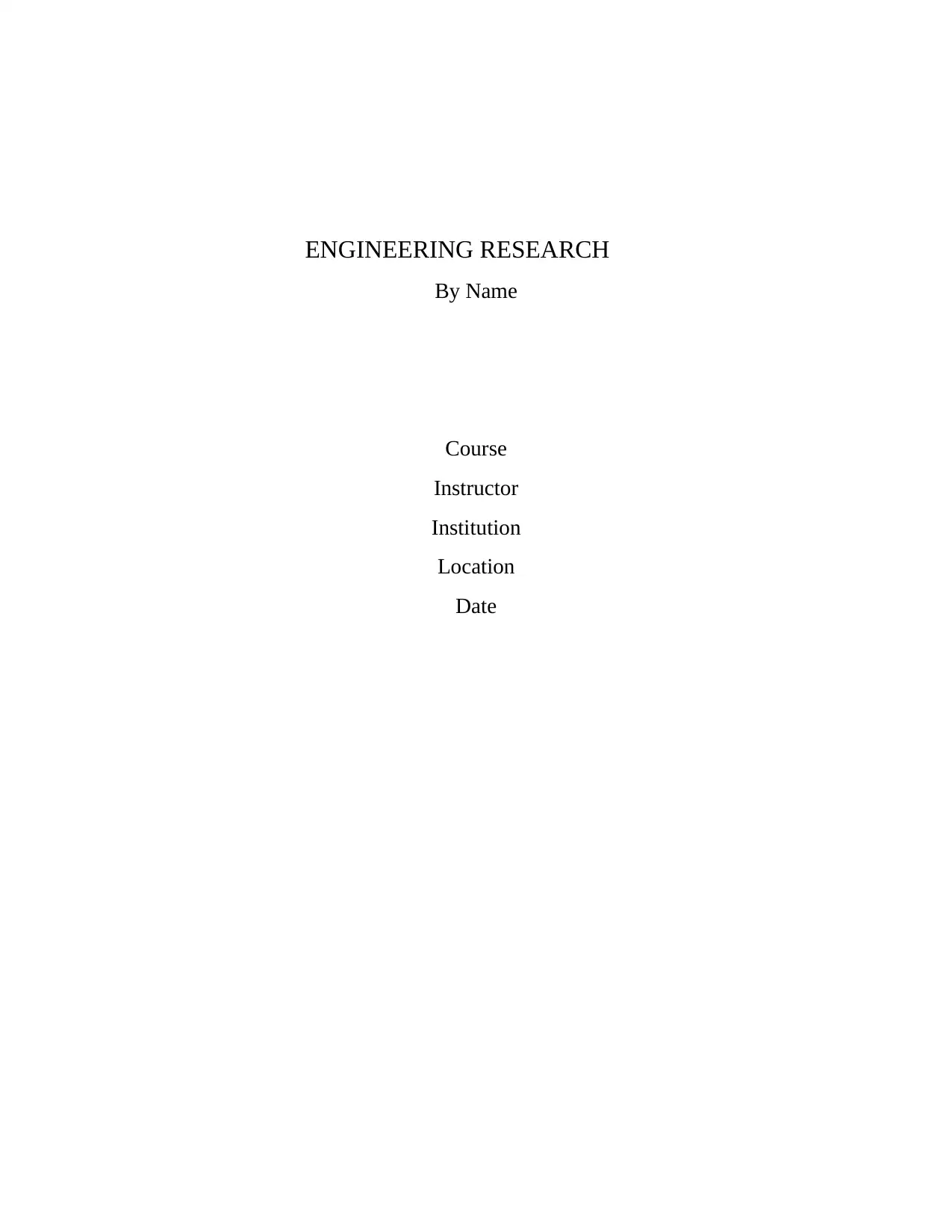
ENGINEERING RESEARCH
By Name
Course
Instructor
Institution
Location
Date
By Name
Course
Instructor
Institution
Location
Date
Paraphrase This Document
Need a fresh take? Get an instant paraphrase of this document with our AI Paraphraser
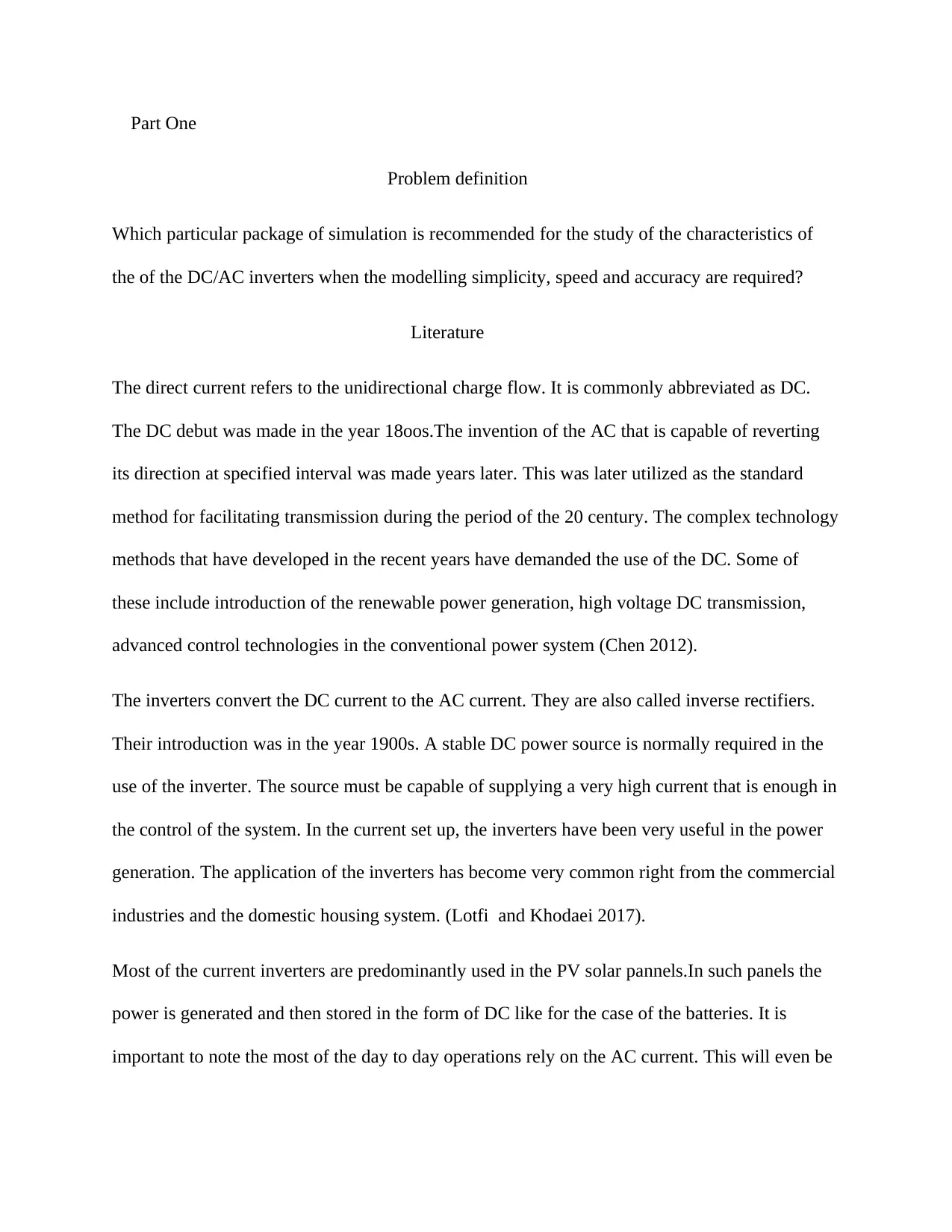
Part One
Problem definition
Which particular package of simulation is recommended for the study of the characteristics of
the of the DC/AC inverters when the modelling simplicity, speed and accuracy are required?
Literature
The direct current refers to the unidirectional charge flow. It is commonly abbreviated as DC.
The DC debut was made in the year 18oos.The invention of the AC that is capable of reverting
its direction at specified interval was made years later. This was later utilized as the standard
method for facilitating transmission during the period of the 20 century. The complex technology
methods that have developed in the recent years have demanded the use of the DC. Some of
these include introduction of the renewable power generation, high voltage DC transmission,
advanced control technologies in the conventional power system (Chen 2012).
The inverters convert the DC current to the AC current. They are also called inverse rectifiers.
Their introduction was in the year 1900s. A stable DC power source is normally required in the
use of the inverter. The source must be capable of supplying a very high current that is enough in
the control of the system. In the current set up, the inverters have been very useful in the power
generation. The application of the inverters has become very common right from the commercial
industries and the domestic housing system. (Lotfi and Khodaei 2017).
Most of the current inverters are predominantly used in the PV solar pannels.In such panels the
power is generated and then stored in the form of DC like for the case of the batteries. It is
important to note the most of the day to day operations rely on the AC current. This will even be
Problem definition
Which particular package of simulation is recommended for the study of the characteristics of
the of the DC/AC inverters when the modelling simplicity, speed and accuracy are required?
Literature
The direct current refers to the unidirectional charge flow. It is commonly abbreviated as DC.
The DC debut was made in the year 18oos.The invention of the AC that is capable of reverting
its direction at specified interval was made years later. This was later utilized as the standard
method for facilitating transmission during the period of the 20 century. The complex technology
methods that have developed in the recent years have demanded the use of the DC. Some of
these include introduction of the renewable power generation, high voltage DC transmission,
advanced control technologies in the conventional power system (Chen 2012).
The inverters convert the DC current to the AC current. They are also called inverse rectifiers.
Their introduction was in the year 1900s. A stable DC power source is normally required in the
use of the inverter. The source must be capable of supplying a very high current that is enough in
the control of the system. In the current set up, the inverters have been very useful in the power
generation. The application of the inverters has become very common right from the commercial
industries and the domestic housing system. (Lotfi and Khodaei 2017).
Most of the current inverters are predominantly used in the PV solar pannels.In such panels the
power is generated and then stored in the form of DC like for the case of the batteries. It is
important to note the most of the day to day operations rely on the AC current. This will even be
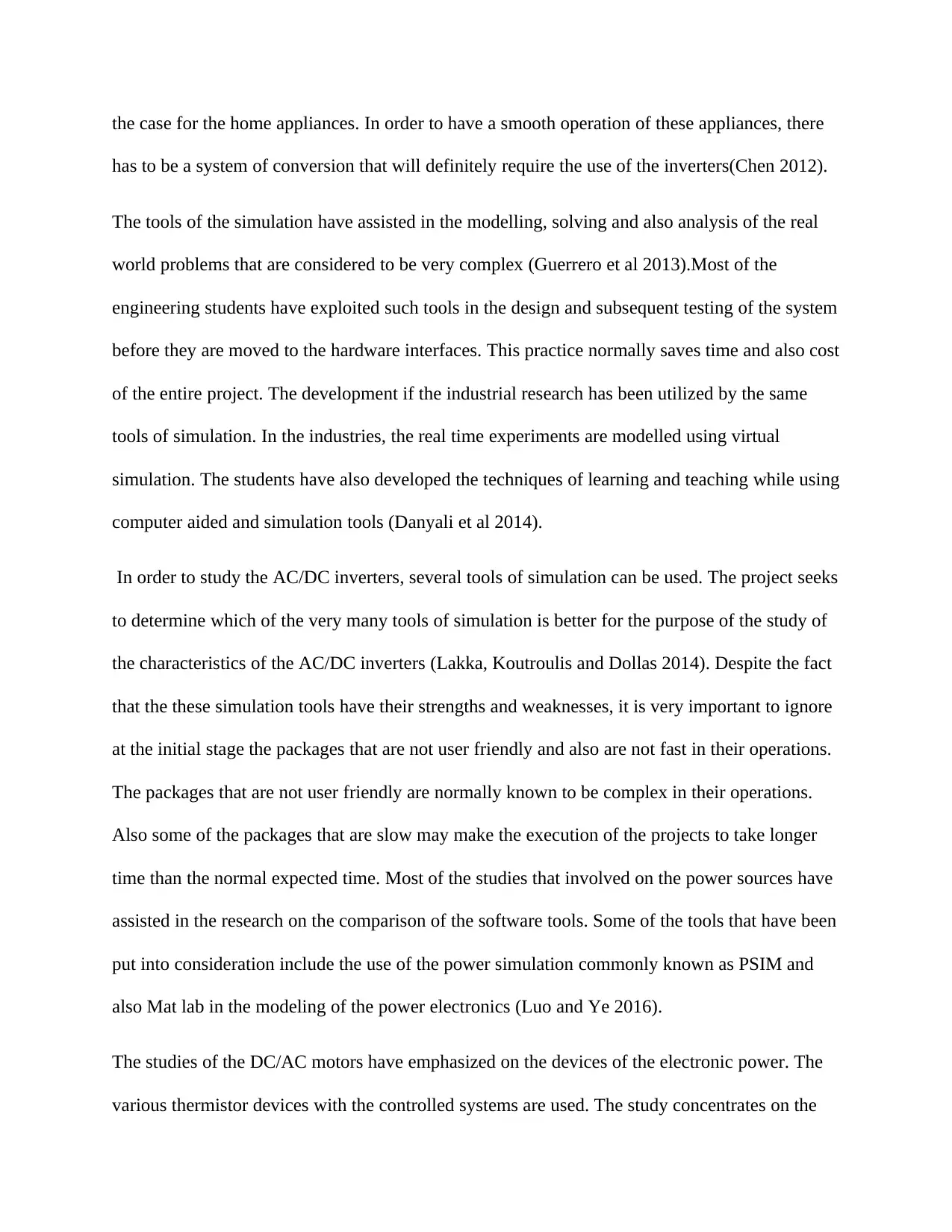
the case for the home appliances. In order to have a smooth operation of these appliances, there
has to be a system of conversion that will definitely require the use of the inverters(Chen 2012).
The tools of the simulation have assisted in the modelling, solving and also analysis of the real
world problems that are considered to be very complex (Guerrero et al 2013).Most of the
engineering students have exploited such tools in the design and subsequent testing of the system
before they are moved to the hardware interfaces. This practice normally saves time and also cost
of the entire project. The development if the industrial research has been utilized by the same
tools of simulation. In the industries, the real time experiments are modelled using virtual
simulation. The students have also developed the techniques of learning and teaching while using
computer aided and simulation tools (Danyali et al 2014).
In order to study the AC/DC inverters, several tools of simulation can be used. The project seeks
to determine which of the very many tools of simulation is better for the purpose of the study of
the characteristics of the AC/DC inverters (Lakka, Koutroulis and Dollas 2014). Despite the fact
that the these simulation tools have their strengths and weaknesses, it is very important to ignore
at the initial stage the packages that are not user friendly and also are not fast in their operations.
The packages that are not user friendly are normally known to be complex in their operations.
Also some of the packages that are slow may make the execution of the projects to take longer
time than the normal expected time. Most of the studies that involved on the power sources have
assisted in the research on the comparison of the software tools. Some of the tools that have been
put into consideration include the use of the power simulation commonly known as PSIM and
also Mat lab in the modeling of the power electronics (Luo and Ye 2016).
The studies of the DC/AC motors have emphasized on the devices of the electronic power. The
various thermistor devices with the controlled systems are used. The study concentrates on the
has to be a system of conversion that will definitely require the use of the inverters(Chen 2012).
The tools of the simulation have assisted in the modelling, solving and also analysis of the real
world problems that are considered to be very complex (Guerrero et al 2013).Most of the
engineering students have exploited such tools in the design and subsequent testing of the system
before they are moved to the hardware interfaces. This practice normally saves time and also cost
of the entire project. The development if the industrial research has been utilized by the same
tools of simulation. In the industries, the real time experiments are modelled using virtual
simulation. The students have also developed the techniques of learning and teaching while using
computer aided and simulation tools (Danyali et al 2014).
In order to study the AC/DC inverters, several tools of simulation can be used. The project seeks
to determine which of the very many tools of simulation is better for the purpose of the study of
the characteristics of the AC/DC inverters (Lakka, Koutroulis and Dollas 2014). Despite the fact
that the these simulation tools have their strengths and weaknesses, it is very important to ignore
at the initial stage the packages that are not user friendly and also are not fast in their operations.
The packages that are not user friendly are normally known to be complex in their operations.
Also some of the packages that are slow may make the execution of the projects to take longer
time than the normal expected time. Most of the studies that involved on the power sources have
assisted in the research on the comparison of the software tools. Some of the tools that have been
put into consideration include the use of the power simulation commonly known as PSIM and
also Mat lab in the modeling of the power electronics (Luo and Ye 2016).
The studies of the DC/AC motors have emphasized on the devices of the electronic power. The
various thermistor devices with the controlled systems are used. The study concentrates on the
⊘ This is a preview!⊘
Do you want full access?
Subscribe today to unlock all pages.

Trusted by 1+ million students worldwide
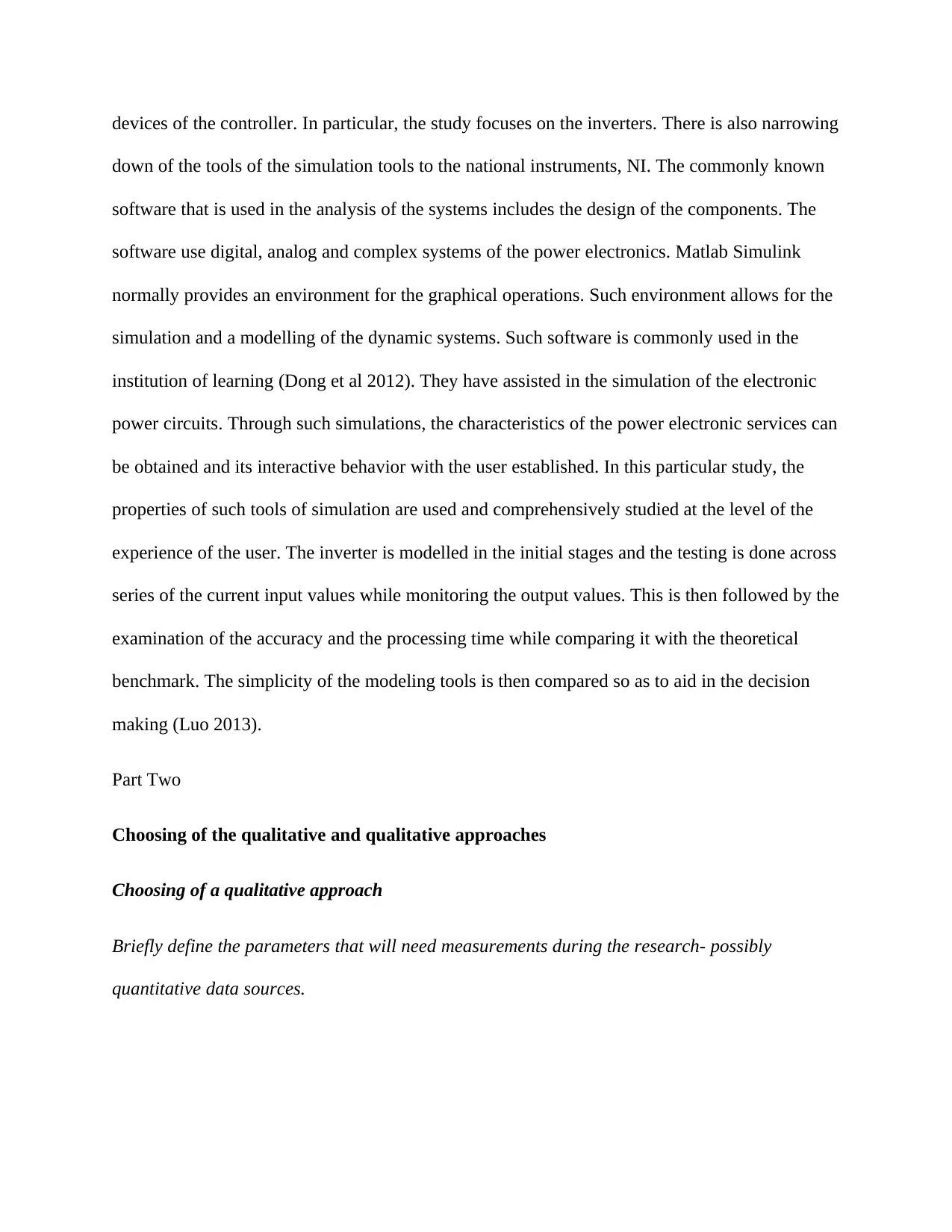
devices of the controller. In particular, the study focuses on the inverters. There is also narrowing
down of the tools of the simulation tools to the national instruments, NI. The commonly known
software that is used in the analysis of the systems includes the design of the components. The
software use digital, analog and complex systems of the power electronics. Matlab Simulink
normally provides an environment for the graphical operations. Such environment allows for the
simulation and a modelling of the dynamic systems. Such software is commonly used in the
institution of learning (Dong et al 2012). They have assisted in the simulation of the electronic
power circuits. Through such simulations, the characteristics of the power electronic services can
be obtained and its interactive behavior with the user established. In this particular study, the
properties of such tools of simulation are used and comprehensively studied at the level of the
experience of the user. The inverter is modelled in the initial stages and the testing is done across
series of the current input values while monitoring the output values. This is then followed by the
examination of the accuracy and the processing time while comparing it with the theoretical
benchmark. The simplicity of the modeling tools is then compared so as to aid in the decision
making (Luo 2013).
Part Two
Choosing of the qualitative and qualitative approaches
Choosing of a qualitative approach
Briefly define the parameters that will need measurements during the research- possibly
quantitative data sources.
down of the tools of the simulation tools to the national instruments, NI. The commonly known
software that is used in the analysis of the systems includes the design of the components. The
software use digital, analog and complex systems of the power electronics. Matlab Simulink
normally provides an environment for the graphical operations. Such environment allows for the
simulation and a modelling of the dynamic systems. Such software is commonly used in the
institution of learning (Dong et al 2012). They have assisted in the simulation of the electronic
power circuits. Through such simulations, the characteristics of the power electronic services can
be obtained and its interactive behavior with the user established. In this particular study, the
properties of such tools of simulation are used and comprehensively studied at the level of the
experience of the user. The inverter is modelled in the initial stages and the testing is done across
series of the current input values while monitoring the output values. This is then followed by the
examination of the accuracy and the processing time while comparing it with the theoretical
benchmark. The simplicity of the modeling tools is then compared so as to aid in the decision
making (Luo 2013).
Part Two
Choosing of the qualitative and qualitative approaches
Choosing of a qualitative approach
Briefly define the parameters that will need measurements during the research- possibly
quantitative data sources.
Paraphrase This Document
Need a fresh take? Get an instant paraphrase of this document with our AI Paraphraser
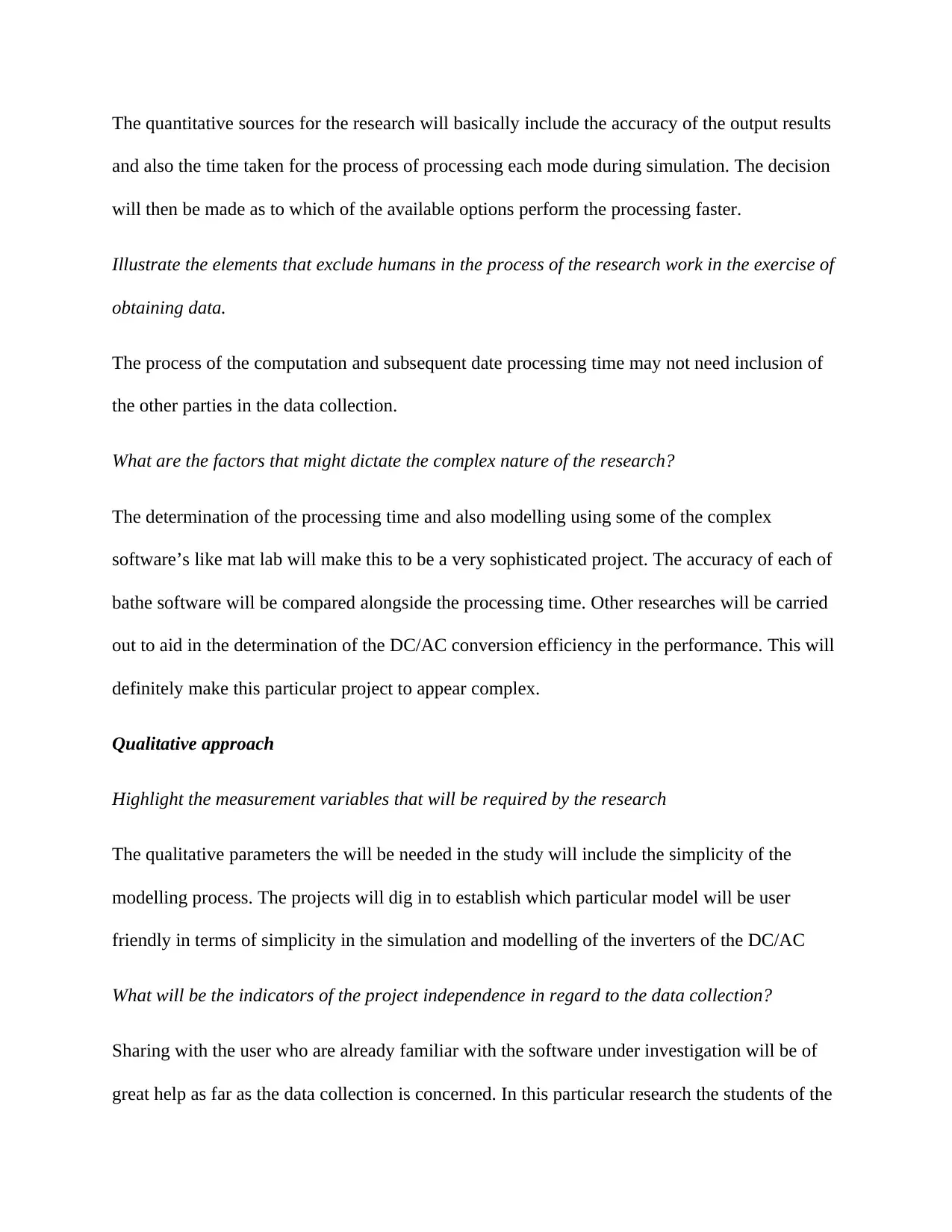
The quantitative sources for the research will basically include the accuracy of the output results
and also the time taken for the process of processing each mode during simulation. The decision
will then be made as to which of the available options perform the processing faster.
Illustrate the elements that exclude humans in the process of the research work in the exercise of
obtaining data.
The process of the computation and subsequent date processing time may not need inclusion of
the other parties in the data collection.
What are the factors that might dictate the complex nature of the research?
The determination of the processing time and also modelling using some of the complex
software’s like mat lab will make this to be a very sophisticated project. The accuracy of each of
bathe software will be compared alongside the processing time. Other researches will be carried
out to aid in the determination of the DC/AC conversion efficiency in the performance. This will
definitely make this particular project to appear complex.
Qualitative approach
Highlight the measurement variables that will be required by the research
The qualitative parameters the will be needed in the study will include the simplicity of the
modelling process. The projects will dig in to establish which particular model will be user
friendly in terms of simplicity in the simulation and modelling of the inverters of the DC/AC
What will be the indicators of the project independence in regard to the data collection?
Sharing with the user who are already familiar with the software under investigation will be of
great help as far as the data collection is concerned. In this particular research the students of the
and also the time taken for the process of processing each mode during simulation. The decision
will then be made as to which of the available options perform the processing faster.
Illustrate the elements that exclude humans in the process of the research work in the exercise of
obtaining data.
The process of the computation and subsequent date processing time may not need inclusion of
the other parties in the data collection.
What are the factors that might dictate the complex nature of the research?
The determination of the processing time and also modelling using some of the complex
software’s like mat lab will make this to be a very sophisticated project. The accuracy of each of
bathe software will be compared alongside the processing time. Other researches will be carried
out to aid in the determination of the DC/AC conversion efficiency in the performance. This will
definitely make this particular project to appear complex.
Qualitative approach
Highlight the measurement variables that will be required by the research
The qualitative parameters the will be needed in the study will include the simplicity of the
modelling process. The projects will dig in to establish which particular model will be user
friendly in terms of simplicity in the simulation and modelling of the inverters of the DC/AC
What will be the indicators of the project independence in regard to the data collection?
Sharing with the user who are already familiar with the software under investigation will be of
great help as far as the data collection is concerned. In this particular research the students of the
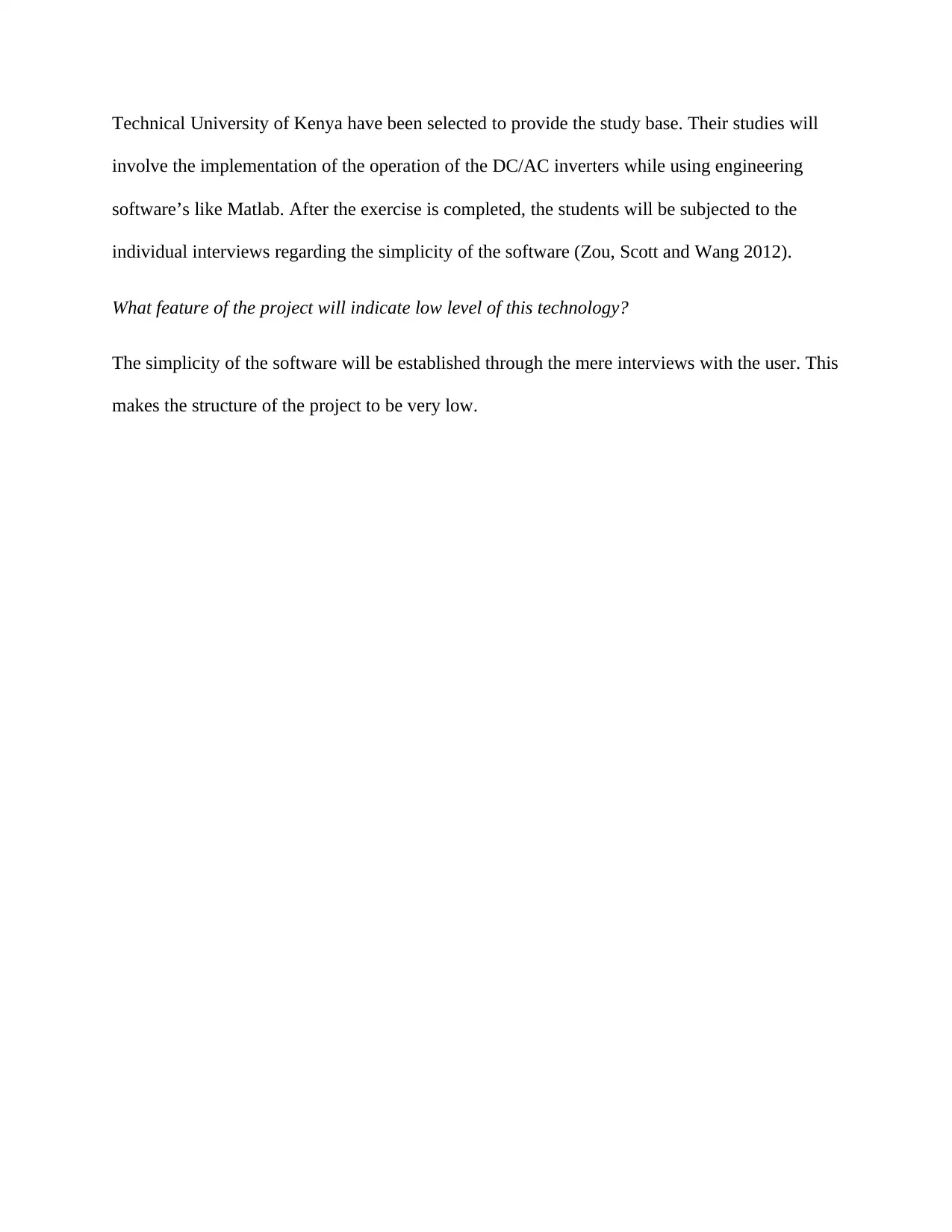
Technical University of Kenya have been selected to provide the study base. Their studies will
involve the implementation of the operation of the DC/AC inverters while using engineering
software’s like Matlab. After the exercise is completed, the students will be subjected to the
individual interviews regarding the simplicity of the software (Zou, Scott and Wang 2012).
What feature of the project will indicate low level of this technology?
The simplicity of the software will be established through the mere interviews with the user. This
makes the structure of the project to be very low.
involve the implementation of the operation of the DC/AC inverters while using engineering
software’s like Matlab. After the exercise is completed, the students will be subjected to the
individual interviews regarding the simplicity of the software (Zou, Scott and Wang 2012).
What feature of the project will indicate low level of this technology?
The simplicity of the software will be established through the mere interviews with the user. This
makes the structure of the project to be very low.
⊘ This is a preview!⊘
Do you want full access?
Subscribe today to unlock all pages.

Trusted by 1+ million students worldwide
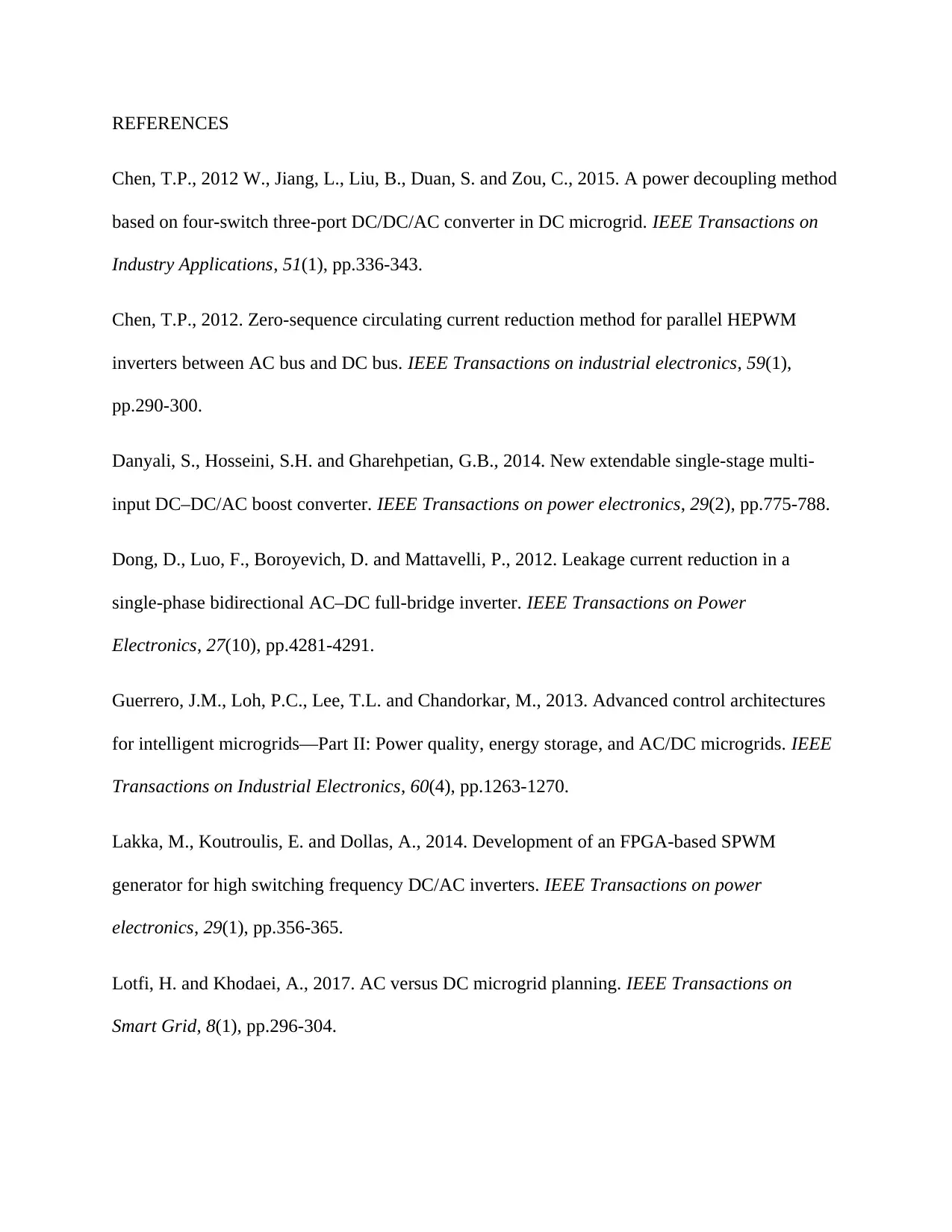
REFERENCES
Chen, T.P., 2012 W., Jiang, L., Liu, B., Duan, S. and Zou, C., 2015. A power decoupling method
based on four-switch three-port DC/DC/AC converter in DC microgrid. IEEE Transactions on
Industry Applications, 51(1), pp.336-343.
Chen, T.P., 2012. Zero-sequence circulating current reduction method for parallel HEPWM
inverters between AC bus and DC bus. IEEE Transactions on industrial electronics, 59(1),
pp.290-300.
Danyali, S., Hosseini, S.H. and Gharehpetian, G.B., 2014. New extendable single-stage multi-
input DC–DC/AC boost converter. IEEE Transactions on power electronics, 29(2), pp.775-788.
Dong, D., Luo, F., Boroyevich, D. and Mattavelli, P., 2012. Leakage current reduction in a
single-phase bidirectional AC–DC full-bridge inverter. IEEE Transactions on Power
Electronics, 27(10), pp.4281-4291.
Guerrero, J.M., Loh, P.C., Lee, T.L. and Chandorkar, M., 2013. Advanced control architectures
for intelligent microgrids—Part II: Power quality, energy storage, and AC/DC microgrids. IEEE
Transactions on Industrial Electronics, 60(4), pp.1263-1270.
Lakka, M., Koutroulis, E. and Dollas, A., 2014. Development of an FPGA-based SPWM
generator for high switching frequency DC/AC inverters. IEEE Transactions on power
electronics, 29(1), pp.356-365.
Lotfi, H. and Khodaei, A., 2017. AC versus DC microgrid planning. IEEE Transactions on
Smart Grid, 8(1), pp.296-304.
Chen, T.P., 2012 W., Jiang, L., Liu, B., Duan, S. and Zou, C., 2015. A power decoupling method
based on four-switch three-port DC/DC/AC converter in DC microgrid. IEEE Transactions on
Industry Applications, 51(1), pp.336-343.
Chen, T.P., 2012. Zero-sequence circulating current reduction method for parallel HEPWM
inverters between AC bus and DC bus. IEEE Transactions on industrial electronics, 59(1),
pp.290-300.
Danyali, S., Hosseini, S.H. and Gharehpetian, G.B., 2014. New extendable single-stage multi-
input DC–DC/AC boost converter. IEEE Transactions on power electronics, 29(2), pp.775-788.
Dong, D., Luo, F., Boroyevich, D. and Mattavelli, P., 2012. Leakage current reduction in a
single-phase bidirectional AC–DC full-bridge inverter. IEEE Transactions on Power
Electronics, 27(10), pp.4281-4291.
Guerrero, J.M., Loh, P.C., Lee, T.L. and Chandorkar, M., 2013. Advanced control architectures
for intelligent microgrids—Part II: Power quality, energy storage, and AC/DC microgrids. IEEE
Transactions on Industrial Electronics, 60(4), pp.1263-1270.
Lakka, M., Koutroulis, E. and Dollas, A., 2014. Development of an FPGA-based SPWM
generator for high switching frequency DC/AC inverters. IEEE Transactions on power
electronics, 29(1), pp.356-365.
Lotfi, H. and Khodaei, A., 2017. AC versus DC microgrid planning. IEEE Transactions on
Smart Grid, 8(1), pp.296-304.
Paraphrase This Document
Need a fresh take? Get an instant paraphrase of this document with our AI Paraphraser
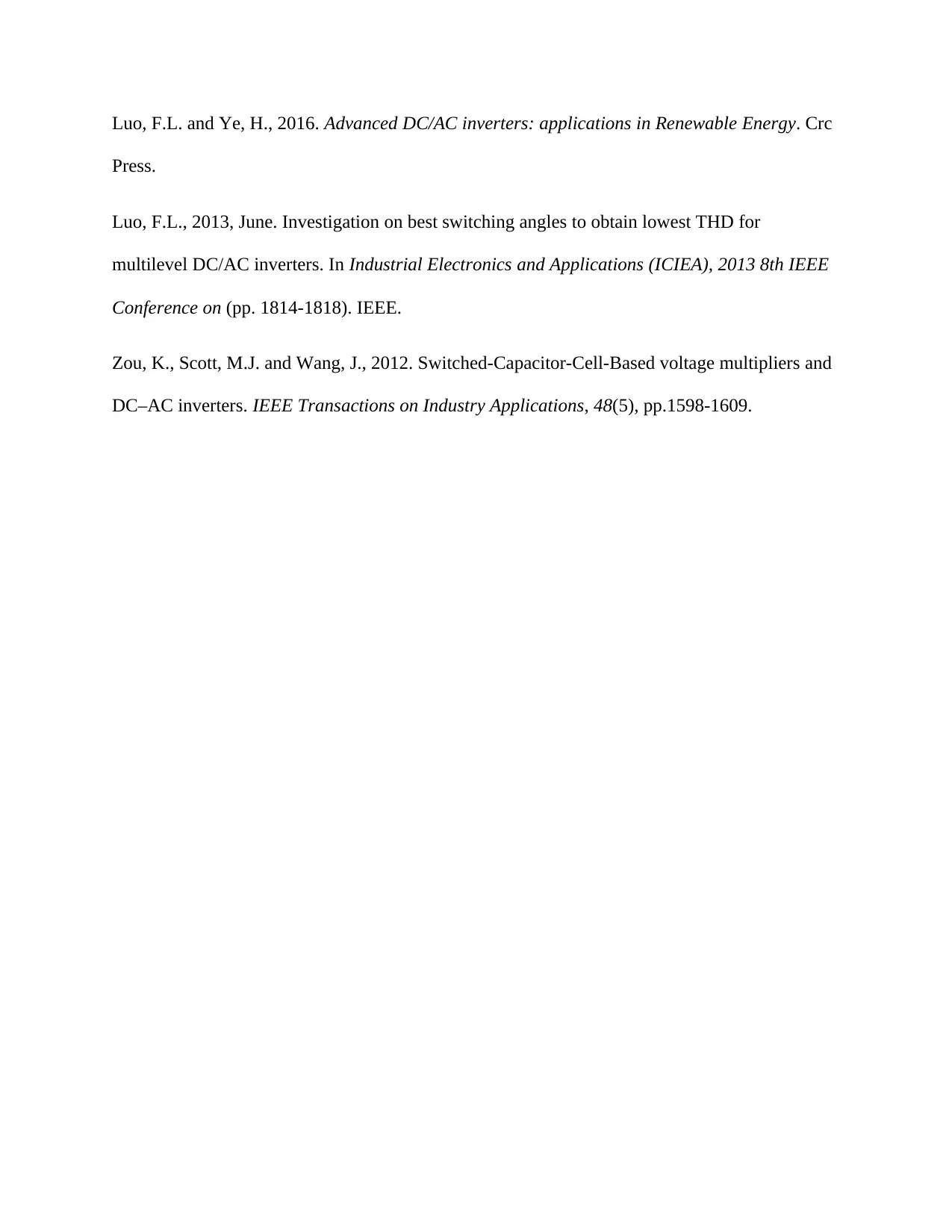
Luo, F.L. and Ye, H., 2016. Advanced DC/AC inverters: applications in Renewable Energy. Crc
Press.
Luo, F.L., 2013, June. Investigation on best switching angles to obtain lowest THD for
multilevel DC/AC inverters. In Industrial Electronics and Applications (ICIEA), 2013 8th IEEE
Conference on (pp. 1814-1818). IEEE.
Zou, K., Scott, M.J. and Wang, J., 2012. Switched-Capacitor-Cell-Based voltage multipliers and
DC–AC inverters. IEEE Transactions on Industry Applications, 48(5), pp.1598-1609.
Press.
Luo, F.L., 2013, June. Investigation on best switching angles to obtain lowest THD for
multilevel DC/AC inverters. In Industrial Electronics and Applications (ICIEA), 2013 8th IEEE
Conference on (pp. 1814-1818). IEEE.
Zou, K., Scott, M.J. and Wang, J., 2012. Switched-Capacitor-Cell-Based voltage multipliers and
DC–AC inverters. IEEE Transactions on Industry Applications, 48(5), pp.1598-1609.
1 out of 8
Related Documents
Your All-in-One AI-Powered Toolkit for Academic Success.
+13062052269
info@desklib.com
Available 24*7 on WhatsApp / Email
![[object Object]](/_next/static/media/star-bottom.7253800d.svg)
Unlock your academic potential
Copyright © 2020–2025 A2Z Services. All Rights Reserved. Developed and managed by ZUCOL.





